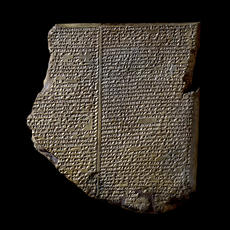Unit 4, Lesson 1: Part Two

Prompt for this blog: Same as Part One but, this time, try it with "Middle East".
Ouchy.
(The Flood Tablet, Nineveh,7th C BCE, Collection of the British Museum)
If I went to try to point to it on a map, I'd end up waving my hand vaguely over a wide area, ranging from somewhere in the vicinity of Turkey to out towards Afghanistan and a few of the other "stans", although I confess that I don't much consider Afghanistan part of the Middle East, myself. Roughly, I suppose that anything between the Indian subcontinent and Greece would qualify.
It's such a vague term: "Middle East".
Of course, the ironic thing about this is that Geography (and Geology) are crucial to any discussion of this diverse part of the planet's surface.
And, oh yeah, Religion.
The words that spring to mind?
"tension".... "war"...."peace process"...."tension"........
There are also place-names that beckon to me from the dawn of time: Ur....Nineveh.....
And places that call from somewhere even earlier: Jericho....Catal Huyuk.....
I watch The Daily Show each night so that I can find some laughter in what's happening in what Jon Stewart calls "Mess-opotamia".
I try to remember that the three Abrahamic faiths are kin to one-another, which is probably why they get along as badly as they do.
Mostly?
I think of War.





